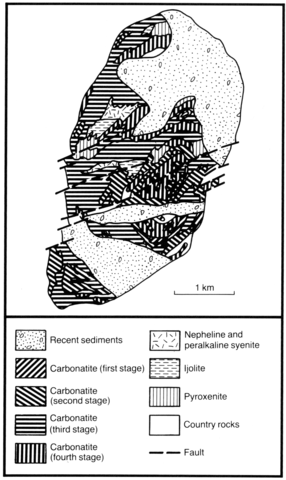stripes
Oval in shape Ozernyi has an area of 9.3 km2 and cuts calcareous terrigenous rocks of Sinian age. About 85% of the area of the complex is composed of carbonatites. Silicate rocks, which have been preserved only in the form of relict blocks, which have diameters of up to 0.6 km, are represented by nepheline-cancrinite syenite, ijolite and pyroxenite. Four stages in the evolution of the complex have been established. Firstly a tube-like intrusion of ultramafic rocks was emplaced. This was followed by intrusion of nepheline-pyroxene rocks and dykes of ijolite porphyry and these in turn by nepheline syenites. Finally, carbonatites were intruded. The ultramafic rocks have been preserved mainly in the northern part of the complex where they form a body with sinuous margins which has an area of 0.12 km2. Pyroxenites are formed mainly of diopside and are often recrystallized. The clinopyroxene is usually zoned from diopside cores to fassaitic rims. Ijolites and nepheline-pyroxene rocks are also found in the form of relict bodies within the carbonatites, the largest of which lie in the centre of the complex. The ijolites are generally uniformly grained, but are sometimes porphyritic, and may also be banded with alternating leucocratic and melanocratic layers. Usually the pyroxene in the ijolites contains up to 30% of aegirine component. Feldspathic ijolites with K-feldspar have been identified. Nepheline syenites comprise two irregularly shaped bodies with areas of 0.12 and 0.05 km2 in the western part of the complex. In addition, they form veins and lenses within the ijolites. The nepheline syenites are fine- and medium-grained and generally have a trachytic texture. They comprise alkali feldspar, in which nepheline is included, clinopyroxene, with 40-45% of aegirine molecule, and biotite. The extensive carbonatites form large, lensoid and vein-like bodies which usually unite into continuous areas. Four types of carbonatite have been identified. (a) Calcite carbonatites with forsterite, diopside, biotite, phlogopite, apatite and accessory perovskite, titanite, zircon and calzirtite. (b) Calcite carbonatites with dolomite, diopside, biotite, phlogopite, tetraferriphlogopite, forsterite, magnesioarfvedsonite and accessory pyrochlore, hatchettolite, baddeleyite, rutile and ilmenite. (c) Calcite-dolomite carbonatites with aegirine, richterite, eckermannite, magnetite, pyrite, pyrrhotite and accessory apatite, zircon, pyrochlore, leushite and aeschynite. (d) Dolomite-ankerite carbonatites with aegirine, magnesioriebeckite, arfvedsonite, chlorite, hydromica, albite, carbonate-apatite, baryte, strontianite, fluorite, zircon, sometimes quartz and with rare-earth minerals usually present including pyrochlore, fersmanite, columbite, monazite, burbankite, carbocernaite, parisite and bastnaesite. Sulphides from calcite carbonatite gave a Ù34So/oo value of -0.2 (Grinenko et al., 1970).
EL'YANOV, A.A. and MORALEV, V.M. 1961. New data on the age of the ultramafic and alkaline rocks of the Aldan shield. Doklady Akademii Nauk SSSR, 141: 687-9.
GINZBURG, A.I. and EPSTEIN, E.M. 1968. Carbonatite deposits. In V.I. Smirnov (ed) Genesis of the endogenic ore deposits. 152-219. Nedra, Moscow.
POZHARITSKAYA, L.K. and SAMOILOV, V.S. 1972. Petrology, mineralogy and geochemistry of the carbonatites of eastern Siberia. Nauka, Moscow. 267 pp.
SEMENOV, E.I., ESKOVA, E.M., KAPUSTIN, U.L. and HOM'AKOV, A.P. 1974. Mineralogy of the alkaline massifs and their deposits. Nauka, Moscow. 247 pp.
ZLENKO, N.D., SHPAK, N.S. and EL'YANOV, A.A. 1966. Ultramafic-alkaline intrusives of the Aldan anticline. In I.I. Krasnov, M.L. Lur’E
(Sette-Daban) and V.L. Masaitis (eds) Geology of the Siberian Platform. 233-42. Nedra, Moscow.

